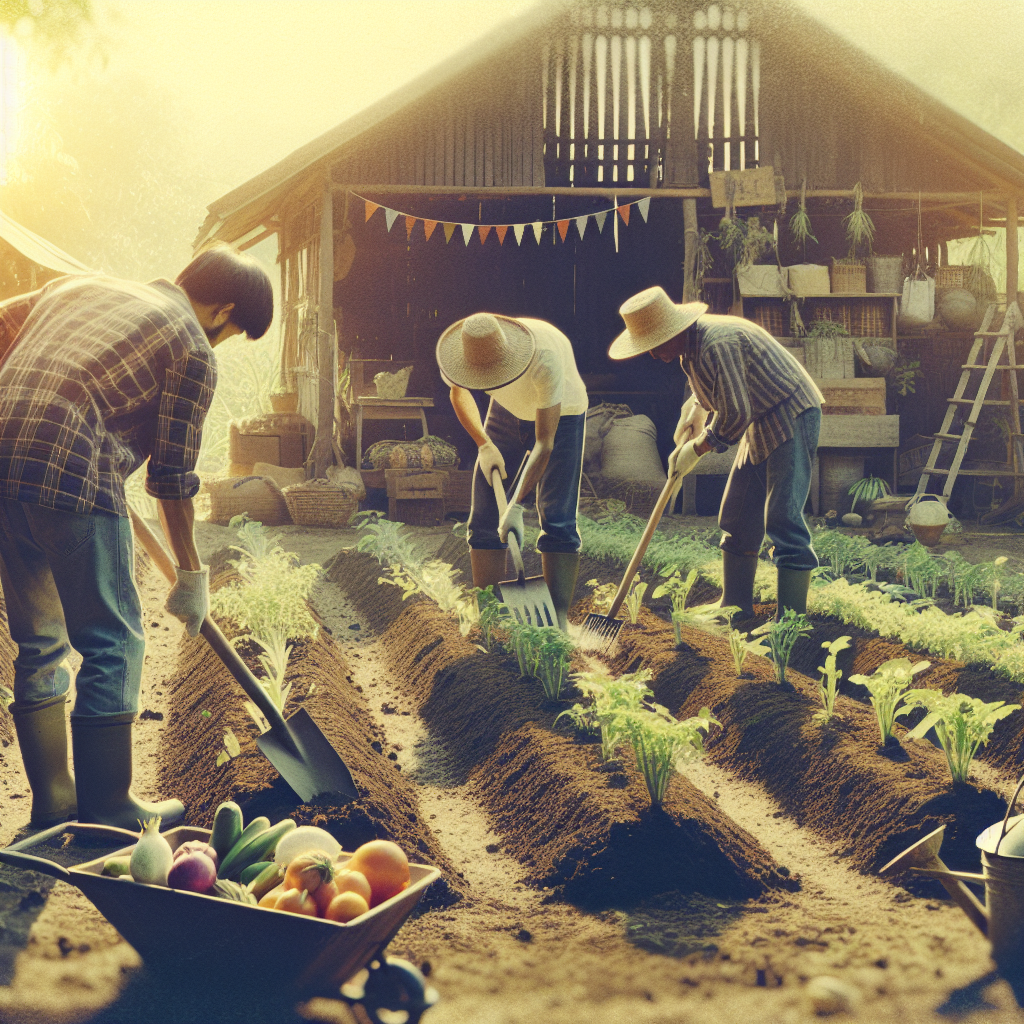Introduction to Community Supported Agriculture
Ever wondered where your food comes from?
As we increasingly seek fresh, locally-sourced produce, understanding different farming models has never been more pertinent.
In this article, we’ll explore the concept of Community Supported Agriculture (CSA), a model that not only ensures fresh produce for consumers but also aids in sustaining local farming communities and the environment.
From understanding what CSA is, how it works, its benefits and challenges, to the role of community participation and the environmental impact, we take you through the entire process. And that’s not all. We’ll also look at how a CSA operates, examine its evolution, consider how technology is shaping its future and how we can advocate for a better food future.
Sounds interesting?
Let’s unravel the wonderful world of Community Supported Agriculture!
Table of Contents
Understanding Community Supported Agriculture (CSA)

What is Community Supported Agriculture?
Community Supported Agriculture (CSA) is a model of farming and food distribution that connects farmers directly with consumers. Through CSA, members subscribe to receive a share of the farm’s harvest, typically on a weekly or bi-weekly basis.
Members pay upfront for a season’s worth of produce, which helps farms cover costs early in the season, and in return, they receive fresh, seasonal produce throughout the growing season.
How CSA Works
The CSA model operates on a few basic principles:
- Subscriptions: Members sign up and pay in advance for their share of the farm’s produce.
- Regular Pick-ups: Members receive regular boxes of produce, which can include fruits, vegetables, herbs, and sometimes other farm products.
- Shared Risks and Rewards: Both farmers and members share the risks of farming, such as poor harvests, and the rewards of bountiful seasons.
Benefits of Joining a CSA
Joining a CSA offers several benefits for both consumers and farmers:
| For Consumers | For Farmers |
|---|---|
| Access to fresh, seasonal produce | Guaranteed market for produce |
| Support for local agriculture | Upfront payment helps with cash flow |
| Variety and learning about new foods | Reduced marketing costs |
| Community connection | Direct customer relationships |
Challenges of CSA
While CSA has many benefits, there are also some challenges:
- Seasonal Fluctuations: The variety and quantity of produce can vary depending on the growing season and weather conditions.
- Commitment: Members must commit to a season and may receive unfamiliar produce, requiring flexibility and creativity in meal planning.
- Pick-Up Logistics: Regular pick-up schedules can be inconvenient for some members.
Finding a CSA Near You
To find a CSA near you, consider exploring local resources and online directories. Websites like LocalHarvest offer searchable databases to find CSAs by location. Joining a CSA can be a fulfilling way to support local agriculture while enjoying fresh, seasonal food.
More Insights on Community Supported Agriculture (CSA)
The Transformation of the CSA Model
Since its inception in the United States in the 1980s, the CSA model has adapted to meet local area needs. Notably, some farms have moved away from the standard share prepayments, offering increased flexibility with pay-as-you-go or sliding scale fees.
Additional CSA Farm Products
While vegetables typically dominate the CSA shares, many farms have diversified their offerings to improve the member experience and income stability. Additional products can include:
- Meat and Dairy: Animal products raised on the farm often command a premium price.
- Grains and Baked Goods: More diversified farms may grow grains and provide milled flour or fresh-baked bread.
- Bees and Honey: Many farms keep bees for pollination and also provide honey to members.
- Eggs: Chickens can offer not just eggs, but their manure acts as a nutritious compost for crops.
- Value-Added Foods: Jams, pickles, sauces, and other shelf-stable foods can help farms extend the season.
Community Participation and Education
CSA farms often emphasize community involvement. Some farms invite members to participate in planting or harvesting crops, as well as social events such as farm-to-table dinners or harvest festivals. CSA farms can also provide educational opportunities to their members and the local community, teaching about sustainable agricultural practices and their role in supporting local, family-owned farms, thereby fostering a greater appreciation for the food system.
Environmental Benefits of CSA
CSAs can offer significant environmental benefits, considering CSA farmers often use sustainable farming methods. These methods can include organic farming practices, minimized use of synthetic fertilizers and pesticides, and practices that improve soil health and biodiversity. A study from Journal of Agriculture, Food Systems, and Community Development notes that CSA participation can reduce food miles and associated carbon emissions because the food does not need to travel long distances.
Understanding CSA from a Business Eye-view
For farmers, despite the guaranteed upfront payment and the direct relationship with the customer, it is important to note that running a CSA involves plenty of administration and planning. Farmers must anticipate demand, decide on the type of shares to offer, and coordinate delivery logistics. It’s often a balancing act that requires effective communication to ensure that members’ expectations are consistently met.
How Does a Community Supported Agriculture (CSA) Production Operate?
Initial Planning and Member Recruitment
Before the growing season begins, CSA farmers need to carefully plan their crop schedules and marketing strategies. They determine the variety and quantity of crops to plant, paying close attention to member preferences and seasonal changes. Next, farmers initiate a recruitment drive to attract members. This often involves using online platforms, local fairs, and community events to spread the word about their CSA.
Seasonal Operations and Planting
Once memberships are secured, farmers focus on planting and maintaining crops. Utilizing sustainable farming methods, they prepare the soil, plant seeds, and maintain crops through irrigation, weeding, and pest management. The goal is to grow a diverse range of produce to ensure variety in the weekly shares members receive. Farmers also conduct regular farm inspections to ensure crop health and prepare for potential obstacles like pests or unexpected weather conditions.
Harvesting and Packing
Harvesting is a vital and labor-intensive part of the CSA cycle. Typically, it’s done in stages to ensure produce is fresh and high quality. Once harvested, farmers pack the produce into boxes or bags designated for each member. Packing usually happens in a designated area on the farm, and care is taken to handle produce gently to avoid damage.
Distribution Logistics
CSA distribution methods can vary. Some farms set up centralized pickup locations—often at the farm, local farmers’ markets, or community centers—where members collect their shares. Others may offer home delivery services. It’s important for farmers to communicate clearly with members about pickup schedules, delivery times, and any changes in the distribution process.
Communication and Feedback
Continuous communication with members is another key aspect of CSA operations. Farmers often send out newsletters or emails detailing the contents of upcoming shares, providing recipe ideas, and sharing updates on farm activities. This communication helps to build a relationship with members and keep them informed about what’s happening on the farm. Additionally, feedback from members is typically encouraged to improve the CSA experience.
Administrative and Financial Management
Behind the scenes, CSA farmers engage in significant administrative work. This includes managing membership databases, handling finances, and ensuring compliance with local regulations. The upfront payment model helps with financial planning, but farmers still need to budget carefully to cover operating expenses throughout the year.
Evaluating and Improving Operations
At the end of the season, farmers usually evaluate the performance of their CSA program. This includes assessing crop yields, member satisfaction, and financial outcomes. They may conduct surveys or hold meetings with members to gather feedback. Farmers use this information to refine their practices and plan for the next season, aiming for continuous improvement in both farming operations and member experience.
Shaping the Future of Community Supported Agriculture (CSA)
Technological Integration in CSA
The future of CSA is being shaped by technological advancements that streamline operations and enhance the member experience. Here’s how technology is playing a role:
- Online Platforms: CSA management platforms like Farmigo and Harvie help farmers manage orders, communicate with members, and handle payments seamlessly.
- Mobile Apps: Mobile applications aid in real-time communication, provide updates on share contents, and can offer recipes and cooking tips using CSA produce.
- Data Analytics: Collecting and analyzing data on crop yields, member preferences, and buying behaviors helps farmers optimize crop planning and improve efficiency.
Sustainable and Regenerative Agriculture Practices
As awareness of environmental issues grows, CSA farms are increasingly adopting sustainable and regenerative agriculture practices. These practices not only improve the farm’s ecological health but also strengthen their marketing appeal:
- No-till Farming: This method reduces soil erosion and improves water retention, making farms more resilient to climate variability.
- Cover Crops: Planting cover crops during off-seasons enhances soil fertility, controls pests, and reduces the need for synthetic inputs.
- Agroforestry: Integrating trees and shrubs into farming systems can improve biodiversity and provide additional farm products like nuts and fruits.
Diversifying Revenue Streams
To mitigate risk and stabilize income, CSA farms are also exploring diverse revenue streams beyond traditional produce shares:
- Workshops and Tours: Offering farm-based workshops and guided tours can attract visitors and generate additional revenue.
- Farm Stands and Markets: Many CSA farms operate farm stands or participate in local farmers’ markets to reach a broader customer base.
- Farm-to-Table Events: Hosting special events, such as farm-to-table dinners, can provide memorable experiences and additional income.
Building Resilient CSA Communities
A key aspect of the future of CSA is the emphasis on community resilience. This involves creating stronger networks between farmers and consumers, as well as fostering collaboration among local food producers:
- Local Partnerships: Collaborating with other local businesses, such as bakeries, breweries, and artisanal producers, to offer a wider range of products to members.
- Education and Outreach: Offering educational programs about sustainable farming practices, nutrition, and the importance of supporting local agriculture can engage and retain members.
- Mutual Support Networks: Developing cooperative networks where CSA farms support each other by sharing resources, knowledge, and marketing efforts.
Policy and Advocacy
Advocacy for supportive policies is critical for the future of CSA. Efforts at both local and national levels can create a more favorable environment for small-scale, sustainable agriculture:
- Farmland Preservation: Policies that protect farmland from urban development ensure the long-term viability of CSA operations.
- Funding and Grants: Access to grants and financial assistance programs can help CSA farms invest in infrastructure and sustainable practices.
- Regulatory Support: Simplified regulations for small-scale farms can reduce administrative burdens and operational costs.
Final Word on Community Supported Agriculture (CSA)
The concept of Community Supported Agriculture (CSA) serves as a unique model allowing for direct interaction between farmers and consumers. It not only fosters a strong community connection but facilitates access to fresh, seasonal and often sustainably-grown produce.
As the CSA model continues to evolve, several farms are now providing diversified products, engaging their community beyond at-source pickup, and leveraging technology to optimize operations and member experience.
While it certainly comes with its challenges, such as seasonal fluctuations and commitment demands, the benefits to consumers and producers alike are multi-fold. Both parties become partners in the farming process, sharing the risks and benefits of food production.
CSA is an innovative way to support local agriculture while making sure your table is graced with the freshest of produce.
Frequently Asked Questions – FAQs
What is Community Supported Agriculture (CSA)?
Community Supported Agriculture (CSA) is a farming model that connects local farmers directly with consumers. Consumers subscribe to get a share of the farm’s harvest, resulting in regular supply of fresh, seasonal produce.
What are the benefits of joining a CSA?
Apart from receiving fresh, local produce, consumers also get the chance to support local agriculture and be part of a community. Farmers get the advantage of early payments, which supports cash flow, and a guaranteed market for their produce.
What are some challenges encountered in CSA farming?
Challenges include seasonal fluctuations, which affect the quantity and variety of produce, the commitment required from members, and logistics around pickup times and venues.
How is technology used in CSA?
Technology is being harnessed to provide farm management platforms, mobile applications, and data analytics. These modifications help optimize operations, improve efficiency and enhance member experience.






